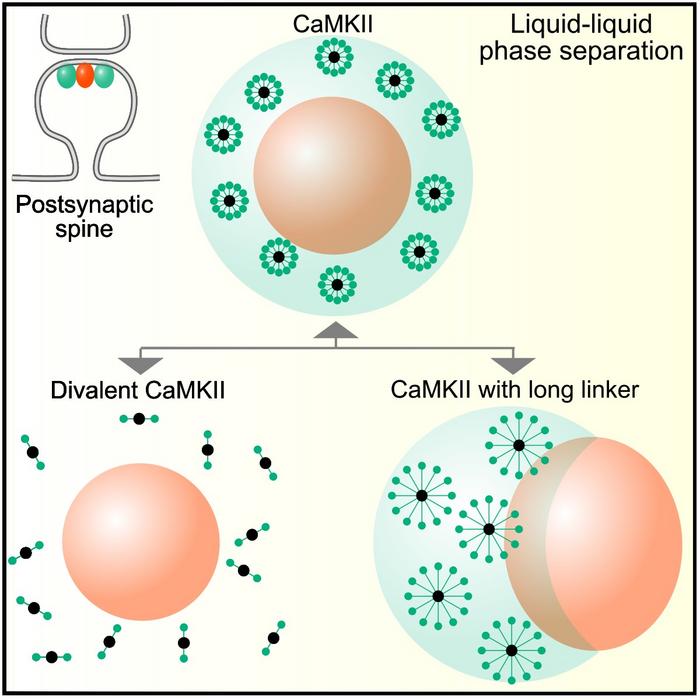
The human brain’s extraordinary capacity to encode, store, and recall memories has captivated neuroscientists for decades. Despite remarkable advances in brain imaging and molecular biology, the fine-grained mechanisms underlying memory formation remain largely elusive. Central to this enigma are the microscopic biochemical processes at the synapse—the communication junction between neurons—where intricate assemblies of proteins orchestrate signals that ultimately translate into learning and memory. Recent computational research has shed new light on this process, revealing how the architecture and molecular characteristics of a key synaptic protein, Ca²⁺/calmodulin-dependent protein kinase II (CaMKII), are fundamental to the creation of complex, multilayered protein condensates that might serve as the molecular basis of memory.
At the heart of this breakthrough is the phenomenon known as liquid-liquid phase separation (LLPS), a biophysical process through which proteins and other biomolecules spontaneously segregate from the surrounding cellular milieu to form concentrated, droplet-like compartments without the need for enclosing membranes. These compartments, or condensates, resemble cellular organelles and create distinct biochemical microenvironments. Previous laboratory studies demonstrated that within postsynaptic densities, several proteins involved in synaptic signaling form dynamic condensates with intriguing “droplet-inside-droplet” structures—layered formations in which smaller protein droplets are nested within larger ones. This multilayered organization has long been suspected to be crucial for controlling the persistence and specificity of synaptic signals, a cornerstone of memory consolidation.
Building upon these experimental observations, a multidisciplinary team led by Dr. Vikas Pandey at Fujita Health University in Japan has harnessed the power of computational modeling to probe the physical principles governing the assembly of these multiphase condensates. Published in Cell Reports, their 2025 study employed advanced simulations to reconstruct how synaptic proteins, most notably CaMKII, interact at the molecular level to form stable, multilayered condensates. The researchers elucidated how subtle structural traits of CaMKII, including its valency—the number of possible binding sites—and the length of its flexible linkers, directly dictate the morphology and dynamic stability of the resulting protein droplets.
The computational simulations faithfully recapitulated the unique “droplet-inside-droplet” topology observed in experimental systems, revealing that the spatial organization hinges on competitive binding interactions among four synaptic proteins studied. The shape and interaction parameters of CaMKII emerged as pivotal factors that modulate interfacial tension and diffusion rates within and between the protein condensates. CaMKII’s compact structure, characterized by a high number of carefully arranged binding domains and short interdomain linkers, produces low surface tension interfaces. This physical property allows the internal droplet phases to resist rapid dissolution or mixing, effectively stabilizing the multiphase architecture against thermal fluctuations that would otherwise disrupt condensate integrity.
The stability of these condensates is not merely a structural curiosity but has profound functional implications. By maintaining sustained and spatially confined assemblies, CaMKII-driven condensates can uphold persistent activation of downstream signaling pathways critical for synaptic plasticity—the cellular basis of learning and memory. The model highlights that the architecture of CaMKII serves as a synaptic memory unit, providing a mechanistic explanation for how molecular interactions at postsynaptic sites translate into lasting changes in synaptic strength. This insight not only fills a critical gap in understanding the molecular underpinnings of memory but also pinpoints structural parameters that could be targeted pharmacologically.
Furthermore, the computational framework offers a versatile platform for exploring how mutations or structural alterations in CaMKII and associated synaptic proteins might disrupt condensate formation and stability. Such disruptions are increasingly implicated in a spectrum of neurodevelopmental and neuropsychiatric disorders, including autism spectrum disorder, schizophrenia, Rett syndrome, and Down syndrome. By simulating pathological variants, researchers can better predict how molecular defects impair synaptic function and identify potential intervention points for therapeutic development.
The implications of this work extend beyond neuroscience. The formation of multiphase condensates is a burgeoning theme across cell biology, implicated in diverse processes from gene regulation to stress responses. These findings cement the importance of protein shape and valency as universal principles directing the assembly of complex biomolecular condensates. The detailed mechanistic insights afforded by this study pave new avenues in designing synthetic biomaterials and molecular systems that mimic natural condensates for applications in biotechnology and medicine.
Importantly, this study underscores the power of computational modeling as a complementary tool to experimental biology. By integrating detailed molecular data and physical chemistry principles, simulation platforms can probe dynamic biological phenomena inaccessible to conventional experimental techniques, accelerating hypothesis testing and discovery. The interdisciplinary approach exemplified by Dr. Pandey’s team highlights the future of neuroscience research, where biophysics, computational science, and molecular biology converge to unravel the mysteries of brain function.
Dr. Pandey emphasizes that their research represents the first systematic and mechanistic investigation into the divergent structures of protein-regulated multiphase condensates at synapses. Their findings provide a structural blueprint for understanding how molecular-scale arrangements produce macroscopic functional outcomes vital for cognition. As research delves deeper into the dynamic nature of synaptic condensates, the prospect of manipulating such assemblies to enhance memory or counteract cognitive decline comes within reach.
In summary, the elucidation of CaMKII’s role in directing multilayered protein condensation heralds a significant advance in our understanding of memory’s molecular infrastructure. By explaining how the distinctive shape and binding properties of a synaptic kinase orchestrate phase-separated condensates, the study offers a compelling mechanistic model linking protein architecture to brain function. Continued efforts to integrate computational and experimental approaches promise to illuminate the complex molecular dialogues that underlie learning and pave the way for novel interventions against neurological diseases.
The journey to decode the molecular lexicon of memory is far from over, yet with each step, we gain clearer insights into the elegant and intricate machinery fueling cognition. Future research informed by these findings holds the potential to transform our approach to neurological health, bringing new hope to millions affected by synaptic dysfunction and memory loss.
Subject of Research:
Not applicable
Article Title:
Multiphasic protein condensation governed by shape and valency
News Publication Date:
7-Apr-2025
Web References:
https://doi.org/10.1016/j.celrep.2025.115504
https://doi.org/10.1038/s41593-021-00843-3
References:
Pandey, V., Hosokawa, T., Hayashi, Y., Urakubo, H. (2025). Multiphasic protein condensation governed by shape and valency. Cell Reports. https://doi.org/10.1016/j.celrep.2025.115504
Image Credits:
Dr. Vikas Pandey, Fujita Health University, Japan
Keywords:
CaMKII, synaptic plasticity, protein condensation, liquid-liquid phase separation, computational modeling, postsynaptic density, memory formation, protein valency, neuroscience, biomolecular condensates
Tags: biochemical processes in memorybrain imaging advancementsdroplet-inside-droplet structuresliquid-liquid phase separationmemory formation mechanismsmolecular basis of learningmultilayered protein assembliesneuroscience and protein dynamicsprotein condensates in neuronsprotein structure modelingsynaptic protein CaMKIIsynaptic signaling architecture





